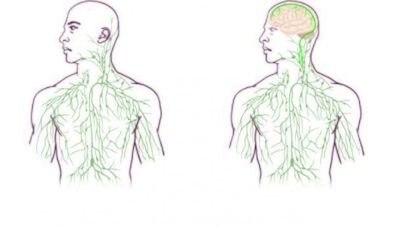"Medical Game-Changer" To Shed New Light on Neuroimmune Diseases
"The discovery of the central nervous system lymphatic system may call for a reassessment of basic assumptions in neuroimmunology and sheds new light on the aetiology of neuroinflammatory and neurodegenerative diseases associated with immune system dysfunction."
In what's being touted as a "medical game-changer" researchers at the University of Virginia have uncovered a new way the brain interacts with the immune system.The researchers were looking for ways immune cells recirculate within the meninges - the protective membranes that envelop the brain - when they stumbled upon an amazing finding in this day and age - a major new anatomical feature of the brain.
 First, they found high concentrations of immune cells around the dural sinuses - veins that drain blood and cerebral spinal fluid from the brain and empty into the jugular vein. A closer look revealed that high numbers of T-cells were aligned linearly along endothelial cell structures along the sinuses. That finding piqued their interest: endothelial cells line the two major transportation venues in the body - the blood vessels and the lymphatic system. Could they have stumbled on an undiscovered pathway between the body and the brain?Further testing revealed the structures were part of a undiscovered section of lymphatic system in the brain. That was a shocker. The anatomy of the brain, they thought, had been fully mapped years ago.
First, they found high concentrations of immune cells around the dural sinuses - veins that drain blood and cerebral spinal fluid from the brain and empty into the jugular vein. A closer look revealed that high numbers of T-cells were aligned linearly along endothelial cell structures along the sinuses. That finding piqued their interest: endothelial cells line the two major transportation venues in the body - the blood vessels and the lymphatic system. Could they have stumbled on an undiscovered pathway between the body and the brain?Further testing revealed the structures were part of a undiscovered section of lymphatic system in the brain. That was a shocker. The anatomy of the brain, they thought, had been fully mapped years ago.
“I really did not believe there are structures in the body that we are not aware of. I thought the body was mapped,” said Dr. Jonathan Kipnis, who runs the University of Virginia lab where the discovery was made. “I thought that these discoveries ended somewhere around the middle of the last century. But apparently they have not.”
Then again, the lymph system has historically been a bit of an odd man out. First described by Hippocrates in 400 BC, it was rediscovered as the "milky veins in the gut of a well fed dog" in the 17th century but then was virtually ignored until 1937 when Howard Florey showed that lymph nodes become enlarged in inflammation.Getting the Garbage OutThe finding helps to solve a longstanding mystery. The brain is a busy place. That almost by definition means its going to produce a lot of byproducts. But where did they go? Absent knowledge of any means of getting rid of toxins, the prevailing hypothesis for many years was that the brain broke down the toxins to their essential elements and then reused them. That hardly passed the smell test but it wasn't until 2012 that one part of the brains waste removal system - the glymphatic system - was identified.[embed]https://www.youtube.com/watch?v=ci5NMscKJws[/embed]Now we know that a traditional - and presumably much more efficient - lymphatic system also exists in the brain. (If I got it right, the authors believe the glymphatic fluids probably drain into the new lymphatic system.)The location of this part of the lymphatic system - situated alongside a major blood vessel - was difficult to see. Unless it was dissected in just right manner it was invisible.The lymphatic network found that runs from the eyes to over the olfactory lobe to the sinuses.
Filtration System
The lymphatic system transports immune cells to lymph nodes - central immune staging areas packed with immune cells. Lymph nodes are also responsible for filtering out foreign particles and cancer cells. Disturb the lymphatic system and you can get a bollixed up immune response and a toxin laden system.Two different types of lymphatic vessels exist: vessels with valves that collect fluid and vessels without valves which fluid passes through. The lymphatic vessels found in this study are valveless- they're designed to let the lymph fluid pass right though the meninges into the neural sinuses and into the lymph nodes.
High Potential
The filtration part of the lymph system appears to be getting the most play right now. The potential this system - or rather the potential a dysfunction of this system - could have on disease is large. In fact one of the researchers went so far as to say that it was hard to imagine a neuro-immune disorder that was not impacted by this pathway.
The potential this system - or rather the potential a dysfunction of this system - could have on disease is large. In fact one of the researchers went so far as to say that it was hard to imagine a neuro-immune disorder that was not impacted by this pathway.
“We believe that for every neurological disease that has an immune component to it, these vessels may play a major role. Hard to imagine that these vessels would not be involved in a [neurological] disease with an immune component.”
He hadn't been drinking too much bubbly. Maiken Nedergaard, director of the University of Rochester Center for Translational Neuromedicine agreed saying that "Essentially all neurodegenerative diseases are associated with the accumulation of cellular waste products. Understanding and ultimately discovering how to modulate the brain’s system for removing toxic waste could point to new ways to treat these diseases.”Picture central nervous system inflammation. Free radicals are punching holes in membranes. Cells are dying. Pathogens are wreaking havoc. The "garbage" that all this activity produces in the form of dead and damaged cells and pathogens needs to be flushed out of the system before more damage results.The classic example of a bollixed up CNS lymphatic system causing disease could be Alzheimer's with it's accumulations of amyloid proteins. One researcher studying Alzheimer's said
“Understanding how the brain copes with waste is critical. In every organ, waste clearance is as basic an issue as how nutrients are delivered. In the brain, it’s an especially interesting subject, because in essentially all neurodegenerative diseases, including Alzheimer’s disease, protein waste accumulates and eventually suffocates and kills the neuronal network of the brain.”
ME/CFS?
Chronic fatigue syndrome could fit in that picture. The high brain lactate levels and low glutathione levels Shungu found in ME/CFS patient brains suggest high rates of anaerobic energy production and its accompanying toxic by-products could be present. The recent Japanese study suggested inflammation was present. Low blood flows to the brain could easily be producing high levels of "garbage". (Stroke is another condition the new findings could illuminate.) Studies indicate that most of the glymphatic flushing that occurs in the brain occurs during sleep - a problematic time for many people with ME/CFS and fibromyalgia. Then there's Dr. Perrin who swears that his lymphatic drainage techniques help people with chronic fatigue syndrome. He believes the cognitive and other problems found in ME/CFS are due to too much sludge in the system.It's not clear how researchers will use this new knowledge but it is clear that tools are present that can exploit this new finding and provide better understanding of neuro-immune disorders - perhaps at some point even ME/CFS.
Studies indicate that most of the glymphatic flushing that occurs in the brain occurs during sleep - a problematic time for many people with ME/CFS and fibromyalgia. Then there's Dr. Perrin who swears that his lymphatic drainage techniques help people with chronic fatigue syndrome. He believes the cognitive and other problems found in ME/CFS are due to too much sludge in the system.It's not clear how researchers will use this new knowledge but it is clear that tools are present that can exploit this new finding and provide better understanding of neuro-immune disorders - perhaps at some point even ME/CFS.
